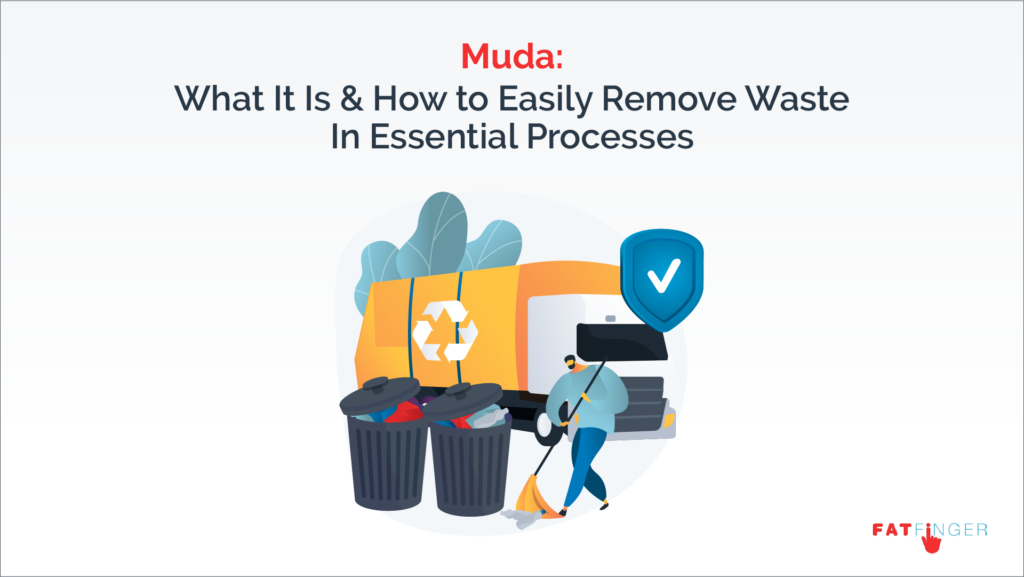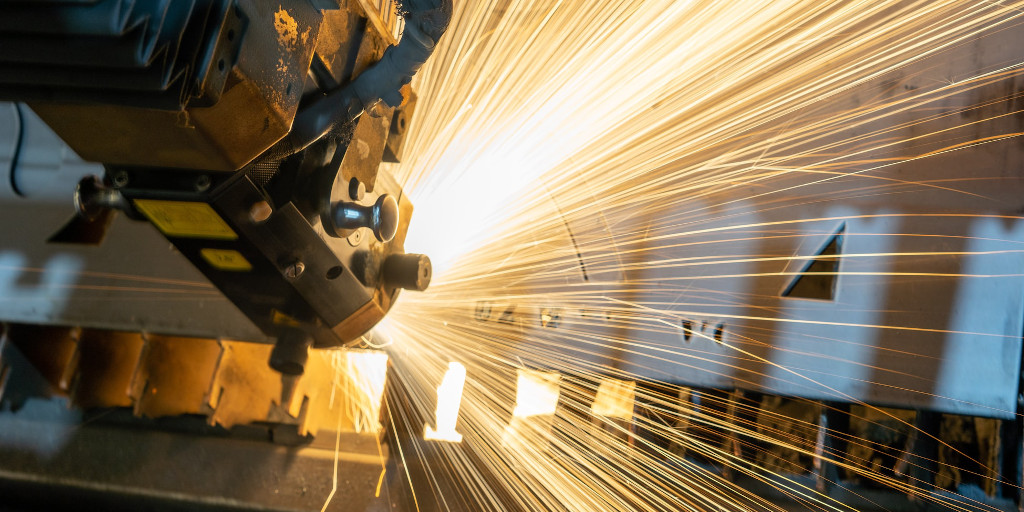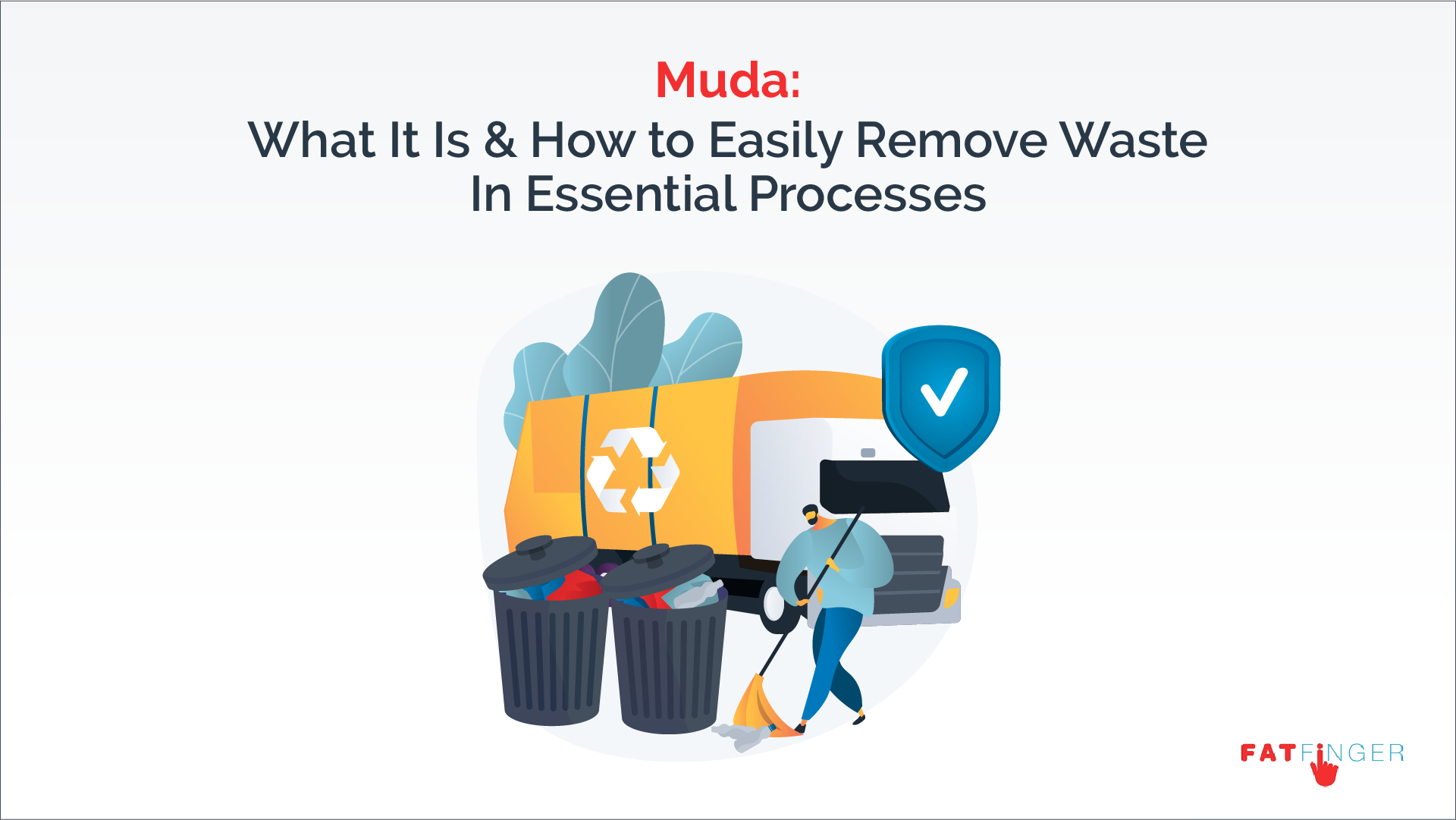
Waste (aka ‘muda’).
It’s something that we just don’t like.
From waking up too late and feeling like we’ve wasted time, to wasting food (us Americans waste over 150,000 tonnes of food each day), to walking along a street that’s piled up with garbage, the majority of us don’t want to contribute to or be surrounded by waste.
But in a business context, the majority of activities we do are wasteful. (Around 40% of the work we do on a daily basis isn’t adding value.)
This means we’re going about our days all wrong. We’re wasting an unprecedented amount of time, money, and effort.
But by understanding muda, businesses can reclaim their processes, their time, and their bottom-line.
To learn all about muda and how to remove business-related waste, I’ve written this FAT FINGER blog post for you.
I’ll be covering:
- What is muda?
- The Toyota Production System and why tackling muda is so important
- Toyota’s seven forms of waste
- How to combat waste in your business processes with FAT FINGER
If the above 40% statistic shocked you to the point where you need to do something about waste in your business right here, right now, then try FAT FINGER. With our tool, you’ll be able to have complete control of your processes and ensure that they’re waste-free.
But if you wanted to understand the basics first, read on!
What is muda?

Muda is the Japanese term for ‘waste’, ‘uselessness’, and ‘futility’, but is most commonly used to mean ‘waste’, and specifically within a business context.
In business, actions that don’t directly provide value to a business are defined as wasteful. Wasteful activities, tasks, and actions then need to be reviewed and in many cases removed from business processes entirely.
(Wasteful actions mostly happen either because business processes aren’t documented, or because the documented processes in question have needless steps that, ultimately, don’t add value to the business. That’s why, when tackling waste, it’s your business processes that you’re primarily working with.)
Muda is more than just a word, though — it’s a mindset, too. By being mindful of waste, knowing what waste looks like, and understanding where waste is present, your business can thrive like never before. And it doesn’t matter what industry, sector, or team you’re a part of; everyone will benefit from understanding muda and then taking action against waste.
With that basic definition over, let’s turn the difficulty up a notch: There are two types of muda.
The definition of muda type 1
Simply put, muda type 1 is a non-value-adding action, but is necessary to happen for the benefit of end customers. While you’ll want to remove muda type 1 waste as much as you can, there will be instances where it’s just not possible.
But that’s OK.
As an example, let’s look at a safety inspection use case.
We all know that safety inspections are necessary to ensure workers remain safe and secure, that tools and equipment are properly cared for, and that unnecessary delays from injuries happening simply don’t, well, happen! Considering its importance, it’s why many teams rely on a safety inspection checklist.
But while being important, it doesn’t add to a business’ bottom-line in a direct, valuable way.
However, in this case, the safety inspection certainly isn’t one to skimp out on, as there are benefits for end customers despite it being a non-value-adding action for the business.
The definition of muda type 2
On the flip side is muda type 2.
This muda type is super simple to understand, and luckily so, because it’s the one you’ll be spending most of your efforts on eliminating!
Muda type 2 is an action that’s non-value-adding and unnecessary for end customers. This, then, means all kinds of muda type 2 wastes need to be removed outright — and quickly.
That’s muda (and the two types of muda) covered.
But where did it come from? How did it start? And by whom?
Let’s find out.
The Toyota Production System and why tackling muda is so important

In our previous post on Kaizen Events, we discussed how American business and quality management teachers inspired some of Japan’s top engineers — namely those working at Toyota.
If you haven’t read the post (you’re missing out!), here’s the gist.
After Toyota put in place quality management steps in their processes and managed to lower costs, reduce problems, and save money — all while producing high-quality products — the rest of Japan noticed and naturally followed suit.
It was only a matter of time until the rest of the world followed in their footsteps, too.
However, it wasn’t just the mere addition of extra quality management steps that secured Toyota’s success. They did much more than that.
And here’s what they did, exactly.
The folks at Toyota went above and beyond, looking at every angle of their business to ensure it was running as efficiently as possible. They — most notably Taiichi Ohno and Eiji Toyoda, Toyota’s senior industrial engineers — devised an entire system known as the Toyota Production System.
Basically, the Toyota Production System is a framework/system that molds together Toyota’s business philosophies with useful practices. Specifically, the Toyota Production System’s main objectives are to eliminate waste (muda), get rid of inconsistencies (mura), and to get rid of overburdening or unachievable tasks (muri) in business processes.
As is written in the foreword for the TPS booklet, that was originally published by Toyota in 1992:
“The TPS is a framework for conserving resources by eliminating waste. People who participate in the system learn to identify expenditures of material, effort and time that do not generate value for customers.” — Toyota Motor Corporation
Muda — the elimination of non-value-adding actions that don’t generate value for the business nor the end customer — is ultimately what’s at the heart of the Toyota Production System. It’s, in essence, what it revolves around, and is the main problem that the system tackles.
Suffice to say, for a leading manufacturing company to devise an entire system to tackle waste (and inconsistencies and overburdening, too), getting rid of muda in all business processes is of utmost importance.
After all, by having waste remain in your business processes, you’re opening your business to negatives such as:
- Slower process completion times.
- Overspending on materials.
- Wasted materials.
- Increased rate of defects occurring.
- Higher levels of customer dissatisfaction.
- Not properly utilizing your employees and their skills.
- Putting too much (needless) work onto your employees’ plates.
I could go on, listing every single waste-related negative, but you get my point.
It’s, unfortunately, time, effort, and money that most crucially gets lost by letting waste remain.
Now that you have a grasp on the Toyota Production System and why muda is a central part of it, let’s take a look at what, exactly, the folks at Toyota define as waste.
Toyota’s seven forms of waste
By reading this far, you know that getting rid of waste is a necessity, and that there are two primary types of muda.
For both muda types though, there are seven forms of waste that need to be eliminated.
These seven forms can be easily remembered with the acronym TIMWOOD, which stands for: Transport, inventory, motion, waiting, overproduction, overprocessing, and defects.
Here’s an explanation of each form of waste, with an example to help you wrap your head around all seven!
The first form of muda waste: Transport

Sure, transporting materials and products needs to happen, but is how you’re going about it wasteful?
Considering that excessive transport can rack up a ton of extra added costs — as well as delays, on top of just making the whole process more complicated — waste in your transport methods is something to keep an eye on at all times.
For this example, I’m going to tell you a little story of when I went on holiday to Sweden.
The Swedish fjords are beautiful. Mountains. Greenery. Snow. Clear lakes.
It’s from one of the clear lakes that, on the day I was leaving, a diver emerged. I struck up a conversation, and it turned out he was diving for a specific type of fish; he had a contract with a French restaurant to catch this specific type of fish so they could serve it to their diners.
Although the restaurant was a well-respected, new venture, it was fairly small in the grand scheme of things. And yet they paid a solo diver to catch some fish, have one of the chefs take a flight to Stockholm to meet the diver, and then bring the fish back via plane again (and on the same day) to France so they could serve it as part of their menu.
Quality is key, yes, but in terms of waste, this is certainly a huge waste when it comes to transport as it added zero value to the end customer — me! I made a reservation at the French restaurant a month later, and had the same lake-dwelling fish the diver had caught.
But to me, it just tasted like…
Well, fish.
All that effort, time, and wild methods of transporting it from A to B added very little to no (and in my case, zero) value.
In a sentence, this is massively wasteful.
The second form of muda waste: Inventory

Inventory costs money. And yet, as a precautionary measure, tons of businesses are wasteful when it comes to their inventory.
For instance, buying extra stock — and maybe even extra space to house that extra stock — in case customer demand quickly rises, or that there are faulty materials elsewhere, or perhaps the cost of materials from vendors rises for some reason.
Just like transporting a box of fish from Sweden to France via an airplane to serve as part of a main course, this is wasteful.
Buying and having extra inventory that you simply don’t need leads to additional costs and additional problems. To go back to muda, it doesn’t add value for the end customer at all.
And, simply put, the mere act of buying extra inventory means there’s usually a waste problem elsewhere in your business.
The third form of muda waste: Motion

Movement, particularly in industries where you aren’t tethered to a desk, like manufacturing and construction, needs to happen for the job to get done.
But are movements being made that are wasteful?
For instance, does it take an unnecessarily long time for an employee to walk from one piece of equipment to the next? Are excessive arm movements happening while those pieces of equipment are being operated?
If employees are having to physically do more than they need to, that’s a surefire way to waste their potential, their labor, and their time. And, again, it’s not adding any benefit for the end customer.
The fourth form of muda waste: Waiting

Waiting is never enjoyable.
But when it comes to business, waiting can be a killer.
(Who was it that said “time is money”, again?)
That’s why the fourth muda waste is waiting. Waiting severely impacts the flow of processes, creates bottlenecks, and can completely upend a project or a product from getting completed on time.
Luckily, this is the easiest form of waste to spot, so it can be tackled quickly. Using the right process-focused software like FAT FINGER will help you to not only eliminate the waste of waiting properly, but actually excel at always moving in a value-adding, non-wasteful way!
The fifth form of muda waste: Overproduction

Ever go to the grocery store, buy more ingredients than you need, then when you’re back at home and have made dinner, realize that you’ve made way too much food?
It’s an easy mistake to make.
But as a business, there’s nothing more wasteful than making more than necessary.
Making more than necessary means you’re meeting customer demand already, and also means that the extra goods aren’t adding any extra value or benefit for the end customer — they’ve already got what they wanted in the first place.
The sixth form of muda waste: Overprocessing

Simply put, overprocessing is the act of doing unnecessary work in a process that the customer doesn’t benefit from.
As a simple example, let’s take this piece you’re reading right now.
I could’ve labored over this for months, ensuring the writing was lyrical and beautifully worded — almost like poetry — and that it was on par with Shakespeare’s writings.
But as a reader, you don’t want that.
You want the facts, and you want those facts explained as quickly and as simply as possible. That’s what’s valuable and beneficial for you.
So instead of overprocessing and overdoing this post, I wrote exactly what’s beneficial for you.
That’s how everything should be in your business.
Otherwise, it’s — you guessed it — wasteful.
The seventh form of muda waste: Defects

Defects cost. In every kind of way.
From reduced team capacity to larger inventories, extra labor, and increased motion activity, product defects means going back all the way to the beginning and starting again.
To stop defects from happening, stricter quality assurance measures should be implemented and process adherence bettered. Defects are one of the most substantial (and needless) forms of muda waste to happen, and are a clear sign that, somewhere, something’s going wrong — and needs to be remedied.
There you have it.
The seven forms of muda wastes, and a few tips and tricks for recognizing and then combatting muda waste.
But to tackle it like a muda pro — and not just once, but continually — you’ll need FAT FINGER by your side.
How to combat waste in your business processes with FAT FINGER
FAT FINGER enables teams to digitize their essential processes, procedures, and workflows with one simple tool.
With our tool’s apps — which are digital checklists — team members can work through their recurring processes with ease, no matter where they’re working from. Our tool has been built with simplicity in mind, making it incredibly simple to start using!
Here’s a quick overview video, explaining how FAT FINGER works.
Now, when it comes to muda specifically, FAT FINGER is your perfect sidekick.
By using FAT FINGER, you’ll first be able to document your team’s recurring processes. As you and your teamwork through the app checklists on a repeated basis, waste will become easier to spot, as bottlenecks and the like will become obvious to all those involved.
This makes tackling waste easier than ever before.
You’ll also be able to make use of FAT FINGER’s state-of-the-art app features — which include assignment features, notification features, authorization features, and real-time dashboard reporting — to make sure that less waste occurs in your business processes going forward.
But it doesn’t end there.
Our nifty tool can help you take things one step further.
You can create app checklists for specific muda-reducing processes, such as the Gemba walk and 5 Whys. Once they’ve been created, you and your team can make your way through them to discover waste issues, and then tackle the muda directly!
Basically, FAT FINGER is the tool to help you have complete control over your business process, once and for all.
Ready to get started?
First, sign up for a free account.
Then watch the video below to pick up some tricks and tricks from FAT FINGER’s very own CEO, James McDonough.
You’re all set!
Here’s to no longer having rubbish, wasteful business processes.


